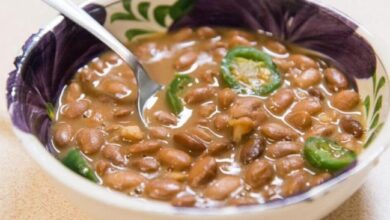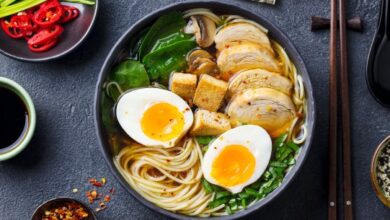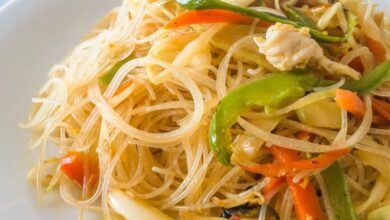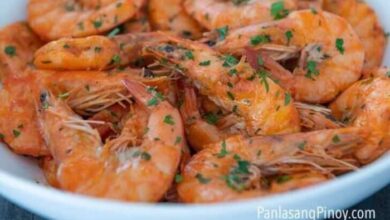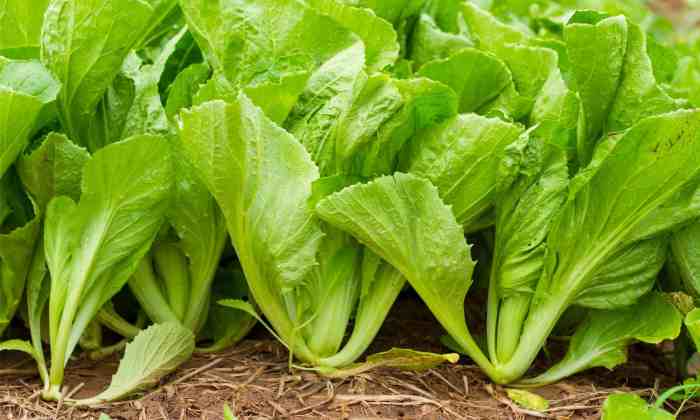
Asian Inspired Mustard Greens: A Culinary Journey
Asian inspired mustard greens, with their vibrant colors and unique flavors, are a culinary treasure waiting to be discovered. These leafy greens have been a staple in Asian cuisine for centuries, adding a delightful crunch and a touch of bitterness to countless dishes.
From the bustling streets of Tokyo to the serene rice paddies of Vietnam, mustard greens have played a significant role in shaping the diverse flavors of Asian gastronomy.
Beyond their culinary appeal, Asian mustard greens are a nutritional powerhouse, packed with vitamins, minerals, and antioxidants. Their versatility in the kitchen makes them a popular choice for both home cooks and professional chefs, finding their way into stir-fries, soups, salads, and even fermented dishes.
In this blog post, we’ll delve into the world of Asian mustard greens, exploring their history, nutritional value, cultivation, and culinary applications.
Asian Mustard Greens
A vibrant green that adds a burst of flavor and texture to Asian cuisine, mustard greens have been a staple in many Asian countries for centuries. Their versatility and health benefits have made them a beloved ingredient, appearing in everything from simple stir-fries to complex stews and soups.
History of Mustard Greens in Asian Cuisine
Mustard greens have a long history in Asian cuisine, dating back thousands of years. Their cultivation and use as a food source have been documented in ancient Chinese texts, and they are believed to have been introduced to other parts of Asia through trade routes.
I love the way Asian-inspired mustard greens add a bright, tangy bite to any meal. They’re especially delicious when paired with rich, savory dishes like slow cooker pork rib tips. The tender, fall-off-the-bone ribs soak up the flavorful sauce, while the mustard greens provide a refreshing contrast.
It’s a winning combination that always leaves me satisfied.
In many Asian cultures, mustard greens are considered a symbol of good health and longevity, reflecting their nutritional value and medicinal properties.
Varieties of Asian Mustard Greens
The diversity of Asian mustard greens is remarkable, with each variety possessing its unique flavor and texture. Some popular varieties include:
- Gai Lan (Chinese Broccoli):A staple in Chinese cuisine, gai lan is known for its thick stalks and tender leaves. Its flavor is slightly bitter and earthy, with a hint of sweetness.
- Komatsuna (Japanese Mustard Spinach):With its long, narrow leaves, komatsuna is a popular ingredient in Japanese cuisine. Its flavor is milder than gai lan, with a hint of peppery spice.
- Tatsoi (Chinese Mustard):Tatsoi features a rosette of round, spoon-shaped leaves. It has a mild, slightly sweet flavor and a tender texture, making it a versatile ingredient.
- Mizuna (Japanese Mustard Greens):Mizuna has deeply lobed, serrated leaves and a slightly spicy, peppery flavor. It is often used in salads and stir-fries.
- Yu Choy (Chinese Mustard Greens):Yu choy has dark green leaves with a distinct white midrib. Its flavor is slightly bitter and pungent, with a hint of sweetness.
Cultural Significance of Mustard Greens in Asian Regions
Mustard greens hold cultural significance in different Asian regions, often reflecting their unique culinary traditions and beliefs.
- China:Gai lan is a popular ingredient in Cantonese cuisine, often served stir-fried with garlic and ginger. It is also used in soups and stews, adding a distinct flavor and texture.
- Japan:Komatsuna is a staple in Japanese cuisine, frequently used in miso soup, stir-fries, and as a side dish. It is also often pickled or used in salads.
- Korea:Mustard greens are often used in Korean cuisine, particularly in kimchi, a fermented dish made with vegetables and spices. They add a tangy and spicy flavor to kimchi, making it a beloved side dish.
- Southeast Asia:Mustard greens are used in various Southeast Asian cuisines, often stir-fried with garlic, chili peppers, and fish sauce. They add a pungent and spicy flavor to dishes, complementing the rich flavors of Southeast Asian cuisine.
Flavor Profiles and Culinary Uses of Asian Mustard Greens
The flavor profiles of Asian mustard greens vary widely, ranging from mild and sweet to pungent and spicy. Their versatility allows them to be used in various culinary applications, from simple stir-fries to complex stews and soups.
- Gai Lan:Gai lan has a slightly bitter and earthy flavor, with a hint of sweetness. It is often stir-fried with garlic and ginger, or used in soups and stews.
- Komatsuna:Komatsuna has a milder flavor than gai lan, with a hint of peppery spice. It is often used in miso soup, stir-fries, and as a side dish. It can also be pickled or used in salads.
- Tatsoi:Tatsoi has a mild, slightly sweet flavor and a tender texture. It is a versatile ingredient, often used in stir-fries, soups, and salads.
- Mizuna:Mizuna has a slightly spicy, peppery flavor. It is often used in salads and stir-fries, adding a unique texture and flavor.
- Yu Choy:Yu choy has a slightly bitter and pungent flavor, with a hint of sweetness. It is often stir-fried with garlic, ginger, and chili peppers, or used in soups and stews.
Nutritional Value and Health Benefits
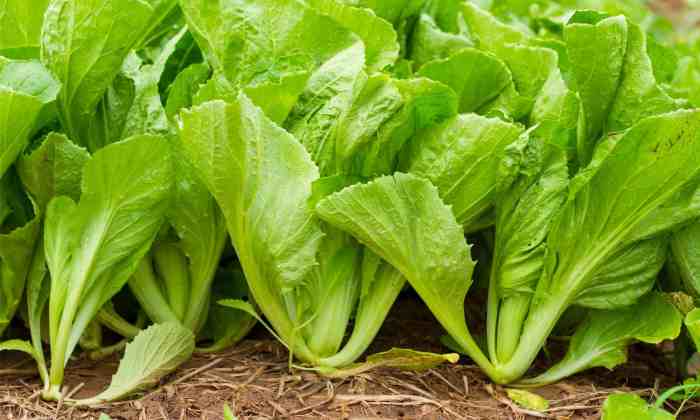
Asian mustard greens are a nutritional powerhouse, packed with essential vitamins, minerals, and antioxidants. These greens are a low-calorie, nutrient-dense food that can contribute to a healthy diet.
Nutritional Composition, Asian inspired mustard greens
Asian mustard greens are an excellent source of several essential nutrients. They are particularly rich in vitamins A, C, and K, as well as folate, calcium, and potassium.
- Vitamin A:Crucial for vision, immune function, and cell growth. One cup of cooked Asian mustard greens provides about 100% of the daily recommended intake of vitamin A.
- Vitamin C:A potent antioxidant that supports immune function, collagen production, and wound healing. One cup of cooked Asian mustard greens contains approximately 50% of the daily recommended intake of vitamin C.
- Vitamin K:Essential for blood clotting and bone health. One cup of cooked Asian mustard greens provides about 150% of the daily recommended intake of vitamin K.
- Folate:Crucial for cell division and growth, particularly important during pregnancy. One cup of cooked Asian mustard greens provides about 10% of the daily recommended intake of folate.
- Calcium:Essential for bone health, muscle function, and nerve transmission. One cup of cooked Asian mustard greens provides about 5% of the daily recommended intake of calcium.
- Potassium:An electrolyte that helps regulate blood pressure and fluid balance. One cup of cooked Asian mustard greens provides about 5% of the daily recommended intake of potassium.
Health Benefits
The abundance of nutrients in Asian mustard greens contributes to various health benefits:
- Antioxidant Activity:The high levels of vitamins C and A, along with other antioxidants, help protect against cell damage caused by free radicals, potentially reducing the risk of chronic diseases.
- Immune System Support:The combination of vitamin C and other antioxidants strengthens the immune system, enhancing the body’s ability to fight off infections.
- Heart Health:The potassium content in Asian mustard greens helps regulate blood pressure, while the fiber content can help lower cholesterol levels, both contributing to heart health.
- Bone Health:The high levels of vitamin K and calcium in Asian mustard greens support bone health, potentially reducing the risk of osteoporosis.
- Digestive Health:The fiber content in Asian mustard greens promotes regular bowel movements and supports a healthy digestive system.
Comparison with Other Leafy Greens
Asian mustard greens compare favorably to other leafy greens in terms of nutrient density. While other greens like spinach and kale are also excellent sources of nutrients, Asian mustard greens stand out for their high vitamin K content and their unique flavor profile.
I’ve been on a real Asian-inspired mustard greens kick lately, and they’re so versatile! They’re amazing in stir-fries, soups, and even as a side dish. The other day I was making a simple stir-fry and thought, “This would be amazing with some crispy chicken!” That’s when I remembered chef Johns chicken under a brick , which is basically a super crispy, juicy chicken breast.
I think the combo of the earthy mustard greens and the crispy chicken would be perfect! Maybe I’ll try it out this week and let you know how it goes.
Cultivation and Preparation: Asian Inspired Mustard Greens
Asian mustard greens are a versatile and nutritious leafy green that can be easily grown at home or in a garden. Their pungent flavor and unique texture make them a popular ingredient in many Asian dishes.
Asian-inspired mustard greens are a vibrant and flavorful side dish that pairs beautifully with a variety of proteins. I recently served them alongside a juicy and tender pork rub rubbed and baked pork chops , and the combination was a real hit.
The subtle heat of the greens complemented the savory pork, creating a well-balanced and satisfying meal.
Growing Conditions
Asian mustard greens thrive in cool weather and prefer full sun to partial shade. They are relatively easy to grow and can be harvested multiple times throughout the growing season.
- Soil:Mustard greens prefer loose, well-drained soil with a slightly acidic pH (6.0-6.5). They can tolerate a range of soil types but perform best in fertile loam.
- Temperature:The ideal temperature range for growing Asian mustard greens is between 50°F and 75°F (10°C and 24°C). They can tolerate some frost but are susceptible to heat stress.
- Watering:Mustard greens require consistent moisture but are sensitive to overwatering. Water deeply and infrequently, allowing the soil to dry slightly between waterings.
- Sunlight:Mustard greens need at least 6 hours of sunlight per day. In hot climates, they may benefit from some afternoon shade.
Cultivating Mustard Greens
- Starting Seeds:Mustard greens can be started indoors or directly sown outdoors. Sow seeds 1/4 inch deep and space them 6-8 inches apart.
- Thinning:Once seedlings emerge, thin them to the desired spacing. Thinning helps to ensure that the remaining plants have enough room to grow.
- Fertilizing:Mustard greens are light feeders and generally do not require much fertilizer. However, you can apply a balanced fertilizer once or twice during the growing season.
- Harvesting:Mustard greens can be harvested when the leaves are young and tender. Cut the leaves just above the soil line. You can harvest multiple times from the same plant.
Preparation and Cooking
Asian mustard greens can be prepared in a variety of ways. They can be eaten raw, added to salads, or cooked in stir-fries, soups, and stews. The leaves can be blanched or steamed to soften their texture and reduce bitterness.
Simple Asian Mustard Greens Recipe
Ingredients:
- 1 pound Asian mustard greens, washed and trimmed
- 2 cloves garlic, minced
- 1 tablespoon sesame oil
- 1/4 cup soy sauce
- 1/4 cup water
- 1 teaspoon sugar
- Pinch of red pepper flakes (optional)
Instructions:
- Heat the sesame oil in a large skillet or wok over medium heat.
- Add the garlic and cook for 1 minute, or until fragrant.
- Add the mustard greens and cook for 2-3 minutes, or until wilted.
- Add the soy sauce, water, sugar, and red pepper flakes (if using). Stir to combine.
- Bring the mixture to a boil, then reduce the heat and simmer for 5 minutes, or until the greens are tender.
- Serve hot with rice or noodles.
Asian-Inspired Recipes and Culinary Applications
Asian mustard greens, with their unique flavor and texture, are a versatile ingredient that can be incorporated into a wide range of Asian-inspired dishes. They are commonly used in both traditional and modern cuisine, adding a touch of bitterness and earthiness to various culinary creations.
Recipes Featuring Asian Mustard Greens
Mustard greens are a staple ingredient in many Asian cuisines, appearing in diverse dishes across various regions. Here are some examples of recipes that showcase the versatility of these leafy greens:
| Region | Dish | Description |
|---|---|---|
| China | Gai Lan with Garlic Sauce | A classic stir-fry dish featuring gai lan (Chinese mustard greens) sautéed with garlic, ginger, and soy sauce. |
| Korea | Kongnamul Muchim (Bean Sprout Salad) | A popular Korean side dish that often includes mustard greens, bean sprouts, and a spicy gochujang dressing. |
| Japan | Miso Soup with Mustard Greens | A comforting and flavorful soup that features mustard greens simmered in a miso broth with tofu and other vegetables. |
| Thailand | Pad See Ew (Stir-Fried Noodles) | A popular street food dish that often includes mustard greens, wide rice noodles, and a savory sauce. |
| Vietnam | Bún Chả (Vermicelli Noodles with Grilled Pork) | A traditional Vietnamese dish that often features mustard greens as a side component, providing a refreshing contrast to the savory flavors. |
Stir-Fried Asian Mustard Greens with Tofu and Shiitake Mushrooms
This recipe offers a simple and flavorful way to enjoy Asian mustard greens. The combination of tofu, shiitake mushrooms, and ginger creates a savory and umami-rich dish. Ingredients:* 1 pound Asian mustard greens, trimmed and washed
- 1 block firm tofu, pressed and cubed
- 1/2 cup dried shiitake mushrooms, rehydrated and sliced
- 2 tablespoons vegetable oil
- 2 cloves garlic, minced
- 1 tablespoon grated fresh ginger
- 1/4 cup soy sauce
- 1 tablespoon rice vinegar
- 1 teaspoon sesame oil
- Salt and pepper to taste
Instructions:
- Heat the vegetable oil in a large skillet or wok over medium heat. Add the tofu cubes and cook for 5-7 minutes, until golden brown. Remove the tofu from the skillet and set aside.
- Add the shiitake mushrooms to the skillet and cook for 3-4 minutes, until softened.
- Add the garlic and ginger to the skillet and cook for 1 minute, until fragrant.
- Add the mustard greens to the skillet and cook for 2-3 minutes, until wilted.
- Return the tofu to the skillet. Add the soy sauce, rice vinegar, sesame oil, salt, and pepper. Stir to combine.
- Cook for 1-2 minutes, until the sauce is thickened. Serve hot over rice.
Incorporating Mustard Greens into Soups, Stews, and Salads
Mustard greens can add a unique flavor and texture to soups, stews, and salads.* Soups and Stews:Add mustard greens to your favorite Asian-inspired soups and stews, such as miso soup, pho, or hot pot. The greens will add a touch of bitterness and earthiness to the broth.
Salads
Mustard greens can be used in salads for a refreshing and slightly bitter element. Combine them with other Asian-inspired ingredients such as tofu, edamame, and sesame seeds.
Fermented Dishes with Asian Mustard Greens
Mustard greens are often used in traditional Asian fermented dishes, where they undergo a process of lactic acid fermentation.* Kimchi:In Korean cuisine, mustard greens are sometimes used in kimchi, a fermented cabbage dish. The greens add a unique flavor and texture to the kimchi.
Pickled Mustard Greens
In Chinese cuisine, mustard greens are sometimes pickled with salt, vinegar, and spices. This process creates a tangy and flavorful side dish.
Visual Exploration
The visual appeal of Asian mustard greens extends beyond their vibrant green hues and delicate textures. From the lush fields where they grow to the enticing dishes they grace, these greens offer a visual feast for the senses.
Asian Mustard Greens in Dishes
A vibrant dish featuring Asian mustard greens might include a stir-fry with thinly sliced pork belly, plump shrimp, and colorful bell peppers. The mustard greens, with their deep green leaves, provide a contrasting backdrop to the bright orange peppers and the glistening seafood.
The dish is further enhanced by a drizzle of sesame oil, which adds a sheen and a nutty aroma. The greens themselves are tender and slightly spicy, their flavor complementing the savory elements of the dish. The overall effect is a harmonious blend of colors, textures, and flavors, creating a visually appealing and delicious culinary experience.
Mustard Greens Fields in Bloom
Imagine a field of mustard greens in full bloom, a sight that evokes a sense of tranquility and vibrancy. The landscape is transformed into a sea of yellow, as the tiny blossoms of the mustard plants unfurl, covering the field in a golden blanket.
The vibrant yellow of the flowers contrasts beautifully with the lush green of the leaves, creating a visually stunning scene. The field is alive with buzzing bees, attracted by the sweet nectar of the blossoms, and the gentle breeze carries the scent of mustard, a sweet and pungent aroma that fills the air.
Still-Life Illustration
A still-life illustration showcasing the textures and colors of different Asian mustard greens could feature a variety of greens arranged on a rustic wooden table. The illustration might include:* Gai Lan:The dark green leaves of gai lan, with their prominent veins, would add a touch of ruggedness to the composition.
Tatsoi
The smooth, rounded leaves of tatsoi would provide a contrasting texture, while their vibrant green color would add a pop of freshness.
Komatsuna
The delicate, serrated leaves of komatsuna, with their lighter green hue, would create a sense of lightness and airiness.
Mizuna
The frilly, deeply lobed leaves of mizuna would add a touch of whimsy and intrigue.The illustration would be enhanced by the inclusion of other elements, such as a rustic wooden bowl filled with sesame seeds, a small jar of soy sauce, and a few chopsticks.
The overall effect would be a harmonious blend of textures and colors, showcasing the beauty and diversity of Asian mustard greens.

